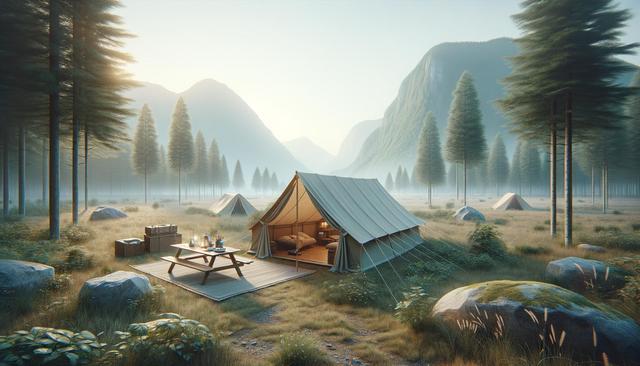Understanding Tent Types for Different Activities
Choosing the right outdoor tent begins with understanding which type suits your intended activity. Tents are often categorized by use-case and seasonality. For casual campers or those visiting well-maintained campgrounds, dome tents offer a balance of space, ease of setup, and affordability. Backpackers, on the other hand, prioritize lightweight and compact models like tunnel or trekking pole-supported tents to reduce the burden during long hikes.
Mountaineering and alpine adventures demand four-season tents engineered to withstand harsh weather, including snow and strong winds. These tents typically feature geodesic frames, reinforced fabrics, and low profile designs for enhanced stability. For group camping or family outings, cabin-style tents provide generous space and vertical walls for better livability. Some of the common tent categories include:
- Backpacking tents – Lightweight and compact for solo or duo travel
- Camping tents – Designed for comfort and space in campgrounds
- Expedition tents – Built for extreme conditions and high-altitude use
- Pop-up tents – Quick setup models ideal for festivals or short trips
By identifying your activity type, you narrow down the best tent options suited to your needs.
Materials and Construction: What Makes a Durable Tent
The durability and performance of a tent are closely tied to the materials used in its construction. The tent fabric, poles, and zippers all play critical roles. Most tent bodies are made from nylon or polyester, with coatings like polyurethane (PU) or silicone for waterproofing. Nylon is lighter and more abrasion-resistant, while polyester excels in UV resistance. The denier rating indicates fabric thickness, with higher values generally offering greater durability.
Poles are typically made from aluminum or fiberglass. Aluminum poles are stronger and more resilient in cold weather, making them preferred in technical and four-season tents. Fiberglass poles are more affordable but prone to splintering under pressure. Tent floors should feature a waterproof rating of at least 1500 mm to ensure protection from ground moisture. Key construction features to consider include:
- Taped or sealed seams to prevent water entry
- Ventilation panels to reduce condensation
- Double-wall designs for better insulation and airflow
- Strong guy lines and reinforced stake points for wind resistance
A well-constructed tent ensures not only protection from the elements but also long-term reliability across multiple trips.
Size, Weight, and Livability Considerations
One of the most common mistakes in tent selection is misjudging the appropriate size. Tent capacities are generally labeled for the number of occupants, but the fit can be tight. For instance, a two-person tent fits two sleeping pads side-by-side with minimal extra space. If comfort is a priority or if you carry extra gear, consider sizing up.
Weight is a crucial factor for those on the move. Ultralight tents can weigh under 2 pounds, while family tents may exceed 10 pounds. When evaluating weight, consider whether you are carrying it in a pack, in a vehicle, or distributing components among a group. Livability features that can enhance comfort include:
- Vestibules for storing gear outside the sleeping area
- Multiple doors for easier access during group use
- Interior pockets and gear lofts for organization
- Peak height and floor area for sitting and moving around
Balancing size and weight with interior comfort helps ensure a positive experience during your outdoor adventures.
Weather Resistance and Seasonal Ratings
Understanding a tent’s weather resistance is essential, especially when venturing into unpredictable environments. Tents are rated by seasonality: 3-season tents are designed for spring, summer, and fall, offering protection against rain and moderate winds. These are the most versatile and commonly used. Four-season tents are built to endure snow loads and alpine conditions, prioritizing strength over ventilation.
Weather protection is often measured by features such as waterproof ratings, wind resistance, and overall design. A flysheet with a high hydrostatic head (over 1500 mm) is vital for rain protection. Wind resistance depends on the pole structure and anchoring system. Additional features to look for include:
- Full-coverage rainfly for better rain and wind protection
- High bathtub floor design to prevent water ingress
- Storm flaps over zippers to block wind and rain
- Adjustable vents to allow airflow even in wet conditions
Choosing a tent that matches the climate and terrain of your destination enhances safety and ensures a more comfortable stay outdoors.
Maintenance and Storage Tips for Longevity
Proper care and storage of your tent can significantly extend its lifespan. After each trip, make sure to clean the tent by shaking out debris and wiping down surfaces with a damp cloth. Avoid using harsh detergents which can damage waterproof coatings. Ensure the tent is completely dry before storing to prevent mold and mildew.
Store your tent loosely in a breathable sack, not compressed in its original bag, to preserve the fabric and prevent permanent creases. Regularly inspect poles, seams, and zippers for wear. Reapply DWR (Durable Water Repellent) treatments as needed to maintain water resistance. A few maintenance practices that help include:
- Using a groundsheet or footprint to protect the tent floor
- Repairing small tears with patch kits before they worsen
- Lubricating zippers to prevent snagging
- Storing in a cool, dry place away from direct sunlight
Routine care not only improves performance but also keeps your tent ready for the next adventure, whether it’s a weekend camping trip or a high-altitude expedition.
Conclusion: Finding the Right Tent for Your Outdoor Goals
Whether you’re a casual camper or an experienced mountaineer, selecting the right outdoor tent involves more than picking a model off the shelf. It requires a thoughtful approach based on your activity type, environment, and personal preferences. By understanding tent types, materials, weather protection features, livability, and maintenance needs, you can make an informed decision that enhances your comfort and safety outdoors. Investing in the right tent is not just about gear—it’s about ensuring a reliable shelter that supports your journey, wherever the trail may lead.








